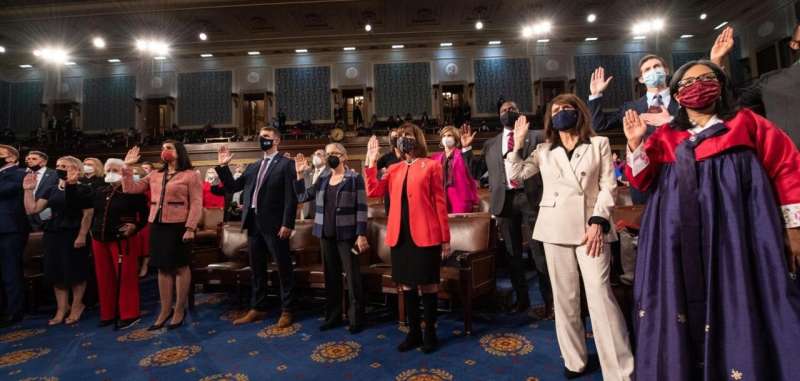Women politicians drive spending on education and healthcare, to a point

When women gain power in national legislatures such as the U.S. Senate or Israeli Knesset, countries begin to spend more on priorities like education and healthcare.
That’s the conclusion of new research led by CU Boulder and published this fall in the journal Political Science Research and Methods.
The study comes as women are winning more seats in parliaments and national assemblies around the globe, but still struggling to gain a majority in many countries.
In Rwanda, for instance, women fill 56%—or 59 out of 106—of the seats in the nation’s parliament—the largest representation of women in any national legislative body in the world. Lebanon, Sri Lanka and Nigeria, meanwhile, join a host of countries where the representation of women languishes in the single digits. The United States falls in the middle, with women holding 27%—or 143 out of 535—House and Senate seats.
“The big question this paper asks is: Does increasing the representation of women in politics actually have a meaningful effect on legislation?” said Hannah Paul, co-author of the new study and PhD candidate in political science at CU Boulder.
To find out, she and her colleagues used machine learning tools to sift through real-world data from nearly 150 nations. They discovered that women’s representation matters, but it’s complicated.
Take education. Based on the team’s calculations, increasing numbers of women in national legislatures can spur a bump in spending on education, but only once they reach about 20% representation. When women occupy more than 40% of seats, however, education spending tends to plateau.
The findings highlight just how complex the relationship between gender and politics can be, said study co-author Andrew Philips, assistant professor of political science.
“When the representation of women is low, politicians tend to treat them like window dressing: They’re there to make the party look good,” he said. “At the same time, you can get to a point where there are so many women in politics that they can now prioritize different issues than they did before.”

Critical mass
The study is the latest to tackle a sticky topic in the field of political science: Critical mass theory. The idea, Philips explained, emerged out of research into the role of women in the business world. Say you’re dealing with a company’s board. If only one or two women sit on a board of 15 people, they might not be able to enact too many changes. Critical mass theory, however, posits that if women leaders hit a minimum threshold for power—say they now hold five out of 15 seats—their influence will increase dramatically.
The problem is that research on the impact of critical mass has been mixed, Paul said.
“This idea has been debated for decades,” she said. “What we’re trying to do is adjudicate whether we should keep this theory around. Or maybe these relationships are more nuanced.”
The researchers, including Kendall Funk from Arizona State University, scanned thousands of data points to get at that question—not only looking at information on nations’ expenditures but also controlling for potentially confounding factors like unemployment, level of democracy and female life expectancy. Previous studies of city mayors and other politicians have shown that women leaders often favor spending on education and health, while men lean into security and transportation.
Sweet spot
The approach panned out. The team discovered that a sweet spot seems to exist where women can affect the most change in the fastest amount of time.
When women occupy roughly 15% to 35% of a country’s legislature, spending on healthcare jumps up sharply from about 6.4% of GDP to more than 6.7%. Beyond that point, however, adding more women to a parliament, assembly or congress no longer moves the spending needle much. At the same time, defense spending plummets as more women join legislatures, leveling off at about 1.8% of GDP, when women reach 35% representation.
“There’s this interval of time in which women are shaping how government spends money on education and healthcare,” Paul said.
Moving forward, the researchers hope to dig even deeper into their data to probe what kinds of impacts these changes might have. Does the presence of women in national legislatures lead to an increase in education levels or the life expectancy of citizens? For now, they said that the results point to one big conclusion.
“The quick takeaway here is that critical mass theory is not dead,” Philips said.
“Pink tax” hurts female consumers, but electing more women combats it
Kendall D. Funk et al, Point break: using machine learning to uncover a critical mass in women’s representation, Political Science Research and Methods (2021). DOI: 10.1017/psrm.2021.51
Citation:
Women politicians drive spending on education and healthcare, to a point (2021, October 26)
retrieved 26 October 2021
from https://phys.org/news/2021-10-women-politicians-healthcare.html
This document is subject to copyright. Apart from any fair dealing for the purpose of private study or research, no
part may be reproduced without the written permission. The content is provided for information purposes only.
For all the latest Science News Click Here
For the latest news and updates, follow us on Google News.

